Who burned Kiev on the eve of Napoleon's invasion?
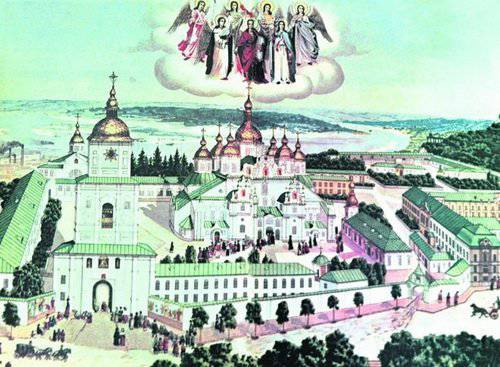
In today's mass consciousness, the Kiev 1811 fire of the year has been completely erased by later events. The Khreshchatyk and the Assumption Cathedral, blown up in September by 1941, overshadowed the dark glory of the previous Kiev catastrophe, when the entire Hem burned down overnight! And in the XIX century, that old “Napoleon” fire was well remembered. After all, the Hem and was then almost all of Kiev. Khreshchatyk as a street did not exist. This name was worn by the usual Yar between the “Upper Town” that had fallen after the invasion of Batu and Pechersk. Around the St. Sophia and St. Michael's Cathedrals in the wastelands came across some huts under the stream. Near the tiny Church of the Tithes, set up in the 17th century, pigs grazed on the site of the one that was destroyed by the Mongol-Tatars. And Podol was everything - the commercial, cultural and administrative center of Kiev. Here was the city government - Magistrate. Next to him is the Academy with the long Gogol Bursaks. And nine-tenths of the then Kiev residents lived precisely on Podol.
Moscow writer Vladimir Izmailov, who had visited Kiev twelve years before the famous fire, described the capital of ancient Russia as follows: “There are no stone houses, there is no order in the building, there is no regularity and architecture. The streets are not paved, the sands cover them. A pedestrian swallows intolerable dust, and a misty pillar winds incessantly around the passing. The Podil itself, more populated than other parts of the city, does not have the appearance of a city at all. Wooden roofs, low huts hide behind churches and a monastery. The streets are so narrow in Podol that hardly two droshki can disperse. Communication between the three parts of the city is extremely difficult, because the mountains separate them from one another. It seems that you see three different villages. I say the villages, for all Kiev hardly deserves the name of the city. ”
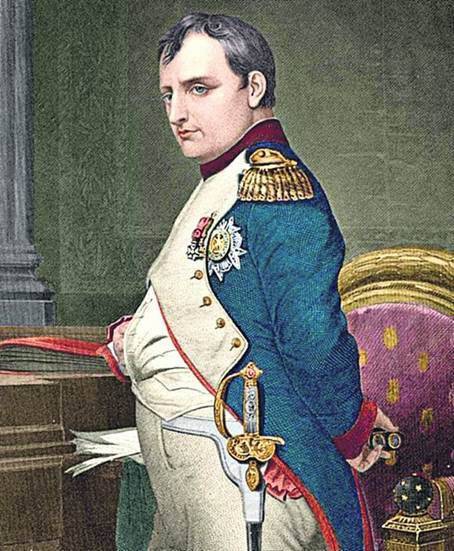
For some reason, the Kievans themselves did not occur to describe their city. “Travel to the noonday of Russia” Izmailov, from where I took this quotation, stood two editions at the beginning of the XIX century. Izmailov belonged to the highest circles of the Russian nobility. He served in the guard, made friends with Karamzin and, having retired early, "voyazhir", as they said, for his own pleasure. His curiosity allowed to preserve the picture of the “pre-fire” Kiev.
Another traveler from Moscow, Prince Ivan Mikhailovich Dolgoruky, left a picture of Kiev to his descendants, which he saw literally a year before the fire. We are used to associate Andreevsky descent with the name of Bulgakov. But the famous view from the St. Andrew’s Church impressed the audience even then. At least those who had the time and desire to raise their heads over the bustle of everyday affairs. Prince Dolgoruky, who lived in Kiev for ten days, pulled to St. Andrew’s Church in order to say goodbye to the city: “The day before I went to look at Kiev again from St. Andrew’s Tower or Gallery: it was towards evening. The sun, ending its run, was hidden from our countries; its sunset was clear and pure; the sky is not darkened, and its azure vault took upon itself the reflection of the last rays of the sun. At such a time of day, I climbed the St. Andrew’s mountain and looked all over Kiev once more in my life. There is nothing more beautiful than this spectacle; I was beside myself from him and could not contain my delights. The Magistrate is built on Podol: it is held by Germanic rites, being a sample of the local town halls. As usual that edge, the trumpeter goes out on the tower, trumpets at dawn and dawn and at noon: the music started playing at that very moment; I heard it from the mountain, and the sound of pipes was heard far down the jets of the Dnieper. Everything contributed to the shock of my feelings; they were alive, fiery, suddenly embraced the past and the present. Saying goodbye to the sun, I said goodbye to Kiev and went home to prepare for departure. ”
Dry statistics show that on the eve of the 1811 fire, Kiev was still like a big “village”. From 3968 Kiev stone houses were only 49! The population barely reached 40 thousand people. And if Izmaylova and Dolgoruky, as Orthodox, pleased Lavr and the Caves, where every pilgrim from central Russia considered it his duty to go, then European travelers would not be moved by anything. Ambassador of the British king Fitz Herbert who visited Kiev in 1787 year together with Catherine II noted: “This is a very sad place, only ruins and huts are visible”. In general, if something burns out, it’s not a pity!
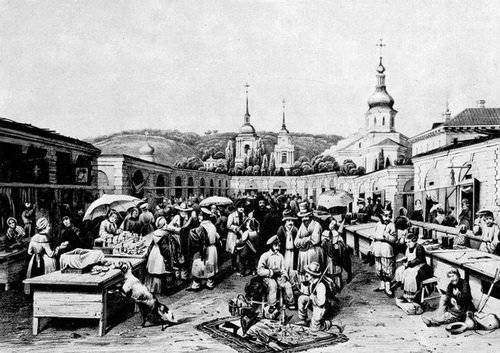
However, ordinary Kievites had something to regret. It was their city. They lived here and, like all local residents, hoped for long and happy years, waiting for them, and not for some new “Pompeii”.
One of those who described the Kiev fire was the historian Nikolai Zakrevsky. In 1811, he was barely six years old. The fire was the most vivid impression of his childhood. The fire broke out in the morning of July 9 around 10 in the morning. At first nobody felt the real danger. Fires in Kiev were frequent and commonplace. In the wooden city every now and then something burned. And this time, the curious rushed to the place where the fire broke out for the first time - between the Zhitniy Market and the Resurrection Church, from which bell tower anxiously struck the alarm. “But the inhabitants were amazed,” Zakrevsky recalled, “when almost at the same time they heard unfortunate news from all the bell towers and then saw a terrible fire in four or five opposite ends of the city. Where to run? Who to help? Everybody turned to his dwelling ... Then it was summer hot and dry, therefore the wooden roofs of the houses easily ignited from the falling sparks; the intensified flames disturbed the equilibrium of the atmosphere and produced a storm, which carried sparks and smut to the greatest space and spread the fire at such a speed that for three hours Kiev-Podol presented itself as a fiery sea. Those who did not have time to escape in advance, running along narrow streets, could no longer find a way out and became the victim of a ferocious element. Many died in the cellars or in the churches; so a few nuns, hoping to find refuge in the large church of Florovsky Monastery, suffocated from the smoke. ”
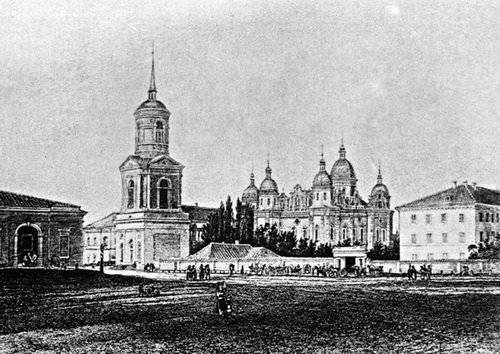
Even the steeples of a few stone churches were smoked. Residents, hoping for non-combustible material of their walls, dragged homemade junk there, saving it from fire. But flames, broke even through the church windows. Everything was burning. The flames were so strong that everyone suddenly felt a kind of stupefaction. Several thousand residents of the Upper Town and Pechersk, gathered on the shaft, stretching from St. Andrew's Church to the Mikhailovsky Monastery, simply watched the fire, without even trying to help the fire victims from Podil. And the Podillian inhabitants themselves did not rush to help each other. The poorest of them used the fire to plunder the homes of those who seemed to them prosperous.
“The horrors of the enraged elements,” continues Zakrevsky, “were soon joined by the horrors of robbery and violence. Our courtyard, located on the street called Black Dirt, was filled with many soldiers and mobile in tatters. These vandals seemed very concerned: they beat off the locks from our closets, carried jams in jars and ate them immediately, taking out their hands and smashing the dishes in a fight; it was the same with drinks - in a word, in a few minutes the storeroom and the cellar were empty. ”
Here it is a picture of the Kiev fire, seen by the eyes of a six-year-old baby! Not heroism, not self-sacrifice, not mutual aid, he remembered, but egoism and valuable for any child banks with jam, which reached the homeless and garrison soldiers. Nobody put out anything. Everyone either saved their property, or robbed someone else's. Narrow streets were literally clogged with furniture and carriages. Everything flew away in the direction of Obolon, which was not yet populated then - behind the Ditch - that is, the Glybochitsa River, which served as the border of the city on Podol.
One of the few who preserved composure in this chaos was Myshkovsky, director of the Kiev gymnasium. His report introduces new details into the Kiev catastrophe: “An eight-week drought and heat prepared the tree for ignition from one spark, the wind expanded, and the reserves of olea, fat, vodka, gunpowder and various trees gave strength to fire on such a space that the coals reached the gymnasium building at Pechersk, the paper flew past 36 versts, to the city of Vasilkov, and during the daytime smoke and glow could be seen beyond 100 versts. The streets, paved with wood, served as a guide to the fire. ”
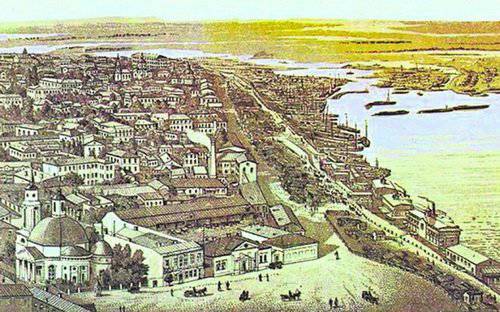
Until 1809, the gymnasium was located in the building of the five-class public school founded by Catherine II on Podol. Shortly before the “great Podolsk fire” the only secondary school in Kiev was transferred to Pechersk. But the library, globes and physical devices still remained in the old Podolsk building. They needed to be saved from fire. The director reported on the battle with fire for the library as follows: “I ran with my household and horses to the theater of horror and screams and, above all, began to rescue the former public school of tools and the library from home. Sacrificing one hundred for the sake of a thousand rubles, I found people for callouts, who gave me tools and books under careful my and my household supervision, ordered some to be carried on hands, others to be taken in carts directly to the gymnasium house ... Having pulled out all the most important things when the school roof had already lit up, I ordered to send everything to the gymnasium in the same manner. In the course of eleven o'clock this work was finished ... I paid for ordinary people immediately with gratitude, and for the relentless scribe of my Lushitsky and for the teacher of the parish school of Nesterovsky I ask ... a noble award, a nobleman ”.
It is not known whether the hero-teachers were granted the nobility, but the salvation of the gymnasium library turned out to be almost the only bright spot in the gloomy stories Kiev fire. As Director Myshkovsky admitted: “I’m very comforted by this mining of the gymnasium, pulled out of the clutches of Pluto with a handful of assistants to the new institution, when at the same time the ancient spiritual Academy, which counts more than a thousand students and several hundred of its own pupils, lost somehow all of its literary belongings "...
Not the number of people, but organization and discipline were important when everything was literally burning. After all, the self-seekers were among the gymnasium teachers. One of them, according to the director, instead of saving the globes, removed the covers from them to use as bags and ran home, saying that the flour was “more important” for him. As happens in extreme situations, everyone showed their “best” qualities. Who took the jam from the children, who stuffed the church with house stuff, who saved the government books. But as soon as the flames faded away, all the people of Kiev started talking about the reasons for such an unprecedented event.
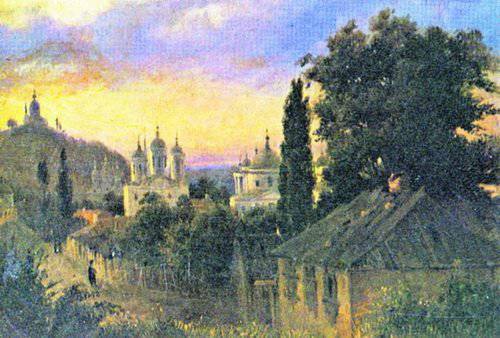
The scale of the fire and numerous fires in different parts of Podil immediately gave rise to a version of a carefully planned sabotage. The time was rampant, anxious. On the Danube was a war with the Turks. There, the Russian army led by the former Kiev governor Kutuzov defended the fortress Ruschuk. Fog rumors were leaking from the western border that Napoleon was increasing the number of troops in Poland and preparing for an invasion of Russia. No one knew which route he would take. To Petersburg? To Moscow? Or maybe to Kiev? What if the fire was organized by the secret agents of the Corsican Monster?
As Nikolai Zakrevsky recalled, he was horrified to observe the plundering of jam from his father's storage rooms, “many later claimed that at the beginning of the fire the police managed to grab several Jews, Poles and even French, who set fire to Kiev's houses by means of lit tinder, hurried candles and other conveniently lit substances. I do not know whether this opinion is true or not. "
It is easy to see that fire victims voiced their own fears. For example, the director of a gymnasium who saved the books was a Pole. In the version of the "Polish trace", he clearly did not fit. To send to the hard work of the “natural Frenchman” is clearly to condemn him to failure. And the Jews suffered from fire in the same way as the rest of Kiev. Did it make sense to set fire to Kiev?
At that time, NO ONE newspaper appeared in the city. Instead of information - just rumors. Someone tells someone how someone saw the police arrest someone. However, soon two subjects were caught at once, who confessed that their craft was “to set fire to cities”. They were a retired sergeant of the Polish army, Shimon Kowalski, and a passport-free passport who introduced himself as “the nobleman of Trlšalka”. The latter claimed that he was part of a secret organization of a certain General Pashkovsky, who had recruited a detachment and had an order from the Polish government to organize a number of arsons in the cities of Right-Bank Ukraine.
Alexander I wanted to know for sure what a scum burned the "mother of cities."
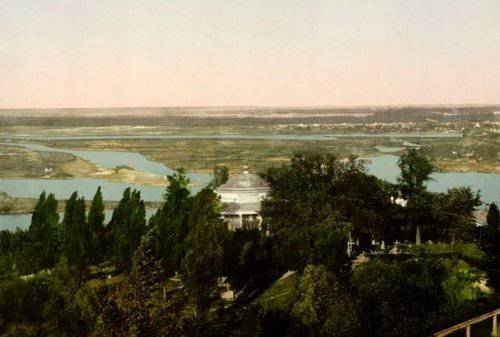
“Still the ruins of Podil continued to smoke,” the pre-revolutionary Kiyevoevist Orest Levitsky wrote about the 1811 fire of the year in the essay “Anxious Years”, - several fires again flared up like 11, 12, 14 and 17 in July. Panicked horror gripped the unfortunate inhabitants. It seemed as if Kiev was once again experiencing those long-past times, which are told in ancient chronicles, when “for all the days you were ignorant and ignited, and I don’t dare to live in a house, but live on the field”. So it was in reality. In the diary of the then Metropolitan Serapion, we read: "On July 14 on 11 in the evening, the packs had a fire in Pechersk, the house of Rybyalsky burned down, and this fire caused such fear that everyone chose all their property from the houses and took them to the field."
Levitsky's article was devoted to the 80 anniversary of the famous disaster. Some of its realities are incomprehensible to the modern reader. Voith is the mayor. His house stood on Pechersk - quite far from Podil, where the first fires were noted. And Metropolitan Serapion, mentioned by Levitsky, lived in wards located in the courtyard of St. Sophia Cathedral. You can see them today. Holy Father also touched the fire. But a bit comic way. Saint Sophia Cathedral, covered with gold and surrounded by a stone wall, as well as the brick palace of the Metropolitan, could hardly catch fire from an accidental spark that reached from Podol. But since Podol was within reach, Serapion suffered a great deal of fear. “We carried out the whole sacristy to the exit, which was under a tent barn,” he wrote in his diary, “almost the whole night did not sleep, and my boxes, wines, and vodka were carried to the basement.”
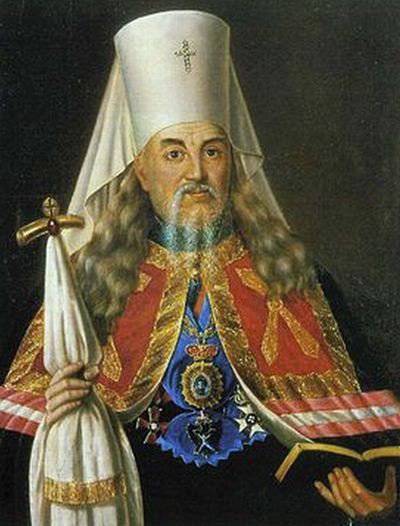
Charming this detail! Together with the “tools of labor” contained in the sacristy, the metropolitan hid the secret delight of the soul - collectible alcoholic beverages. It can be seen that their safety was extremely disturbed by the head of the Kiev diocese, since the Orthodox pastor noted in a special article his efforts to save them.
All the rest clearly spoke of the deliberate nature of the fire. It began almost simultaneously in different parts of Podil. And then the foci flared up several more times in Pechersk, although at that time it was, in fact, a separate city. Between him and Podil lay undeveloped Khreshchatyk. In the place of the current Maidan Nezalezhnosti there was a goat swamp. Like any swamp with ducks and toads, it was weakly susceptible to fire. In the area of the current Theater of Ukrainian drama was a pond. On the slope from Kreschatik up to the Royal Palace rose a thick forest. It was not necessary to be a rocket scientist to assume the existence of a special gang of intruders that set fire to Kiev from various sides. Is that the local government did not have to suspect. If the house of the mayor himself burned down, then he certainly was not on fire.
From the very beginning, the imperial government was convinced that Kiev’s fire was a sabotage. The Kyiv governor Miloradovich, the one who the Decembrists in Senatskaya Square would kill in thirteen years, immediately reported Alexander I to St. Petersburg about "suspicions of intruders." In response, the emperor ordered an experienced official to be sent to Kiev to produce an investigation, in order to "find the attackers in arson and the reasons for such a crime." In Kiev itself, a commission of inquiry was formed under the chairmanship of the local chief of police, and residents were asked to inform her of all suspicious facts.
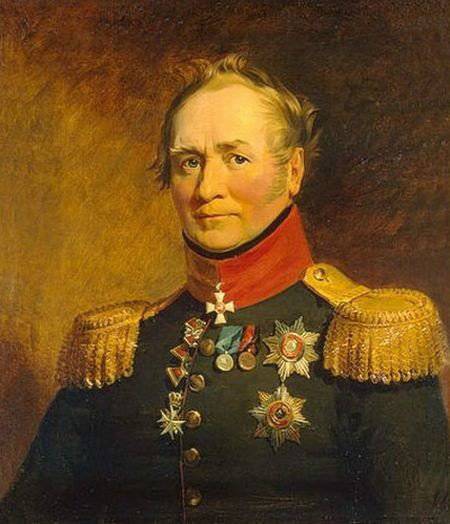
And then the bacchanalia began, capable of explaining the psychological phenomenon of even the Stalinist repression, before which there was still more than a century. Voluntary assistants literally flooded the commission with "facts." Someone from the Orthodox brought Jews, “who carried a broom along the street” - naturally with the aim of arson. Others dragged the company of the Polish nobility, "walking along the lanes, gracefully, for the ignition of houses." Jews, too, did not lag behind in the "vigilance" of other ethnic groups of multinational Kiev - one of them told the police chief that he had heard in the wine cellar of a merchant Ryabchikov in Pechersk a story by David Molenko, an apprentice at the Mezhigorsk faience factory, about "people of Great Russian breed" with pipes birch bark full of gunpowder. They allegedly roam around Kiev, and with them two more Jews, and they all belong to the gang of arsonists in the number of 5000 people. The gang was sent by the Poles and the French, and at the head of it were “three colonels who roam everywhere, wearing a woman's dress” and pay the arsonists for 25 rubles a day.
Eloquent Molenko found and dragged to the police. There he admitted that he was saying everything drunk, wanting to amuse the audience. The authorities believed him, but sent him to the Poviet Court in Kiev for legal retribution for dismissing false rumors. And the result, and the townsfolk more and more confused in the most fantastic versions.
GREAT DETECTIVE ANICHKOV. Finally, exactly 12 of August, a month after the fire, the investigative police officer Anichkov arrived in St. Petersburg - the then “star” of the all-Russian investigation, in a drunken and sober form, uncovering the most complicated criminal cases. Kiev met him with a "firework" - immediately after Anichkov's arrival, they caught fire and safely burned to the ground by the house of a certain Mrs. Leontyeva, the lieutenant of Kort and the poorhouse with a pharmacy. Rumors of the instigators began again.
But experienced Anichkov, who had long befallen false human nature, investigated all three fires and came to the conclusion that in two cases, the reason was careless handling of fire, and in the third, in a minor moron. The house of the Court was really burnt down by arson, but it was not the agents of the French who burned it, but a twelve-year-old yard boy. The young pyromanic picked up a bunt on another fire, went to the stable with her and threw it into the hay, wanting to see "what will happen from this." The talent of the great physicist, strangled by the harsh times of serfdom, was clearly hidden in the half-wit. The boy was poured, as it should, from which he grew wiser before his eyes and came to the logical conclusion that he should not do more.
An outstanding detective Anichkin showed no less than the ability to resist the opinion of the crowd in investigating the circumstances of the great Podolsk fire of early July. After questioning eyewitnesses, he found that the version of the simultaneous fire in several places should be discarded, despite all its seductiveness. Initially, only one estate caught fire - tradesman Avdievsky. And already from her the wind blew the fire along the Hem.
"I thought to make fireworks". An official from Petersburg interrogated the family of Avdievsky and his tenants. As Orest Levitsky writes, “During this interrogation, Avdiyevsky’s 15-year-old son Vasily frankly confessed that while his father and his mother were indulging in afternoon nap, he fixed a goose feather with powder and, going out to the yard, he decided to arrange a firework; when his hands burned to him, he threw the charge into the straw lying in the yard and, seeing that it caught fire, was frightened, ran away from the yard and disappeared in the crowd of fire victims for two days, unable to find the parents.
One should not be surprised that Kiev burned to the ground, but that it remained whole for so long while completely ignoring any fire safety requirements. Wooden houses covered with “shingles”, that is, the same tree and straw, sheds full of hay for horses, heaps of old rubbish, sidewalks from planks along the streets could be heated with any negligence. It was necessary just a hot summer and ... a spark.
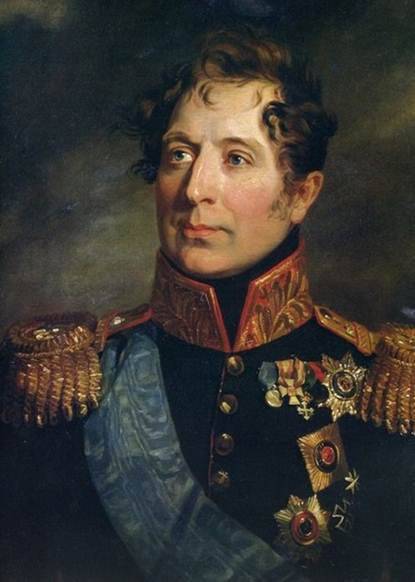
Governor Miloradovich was extremely pleased with the investigation carried out by Anichkov, and petitioned the emperor to award him. Alexander I ordered to declare the royal favor to the investigating bailiff. But the king did not deem it necessary to give up the version of sabotage and demanded that Anichkov not rest on his laurels and "put all the effort to find the attackers in arson." No matter how hard the detective master tried, he failed to uncover the damned agents of Napoleon or some other villain - a month later an honest bailiff, stubbornly holding his opinion, was recalled to the capital.
SECRET SIGNS. However, in September, rumors of the atrocious arson of Kiev received unexpected reinforcements. In the Balts povet of Podolsk province a man was caught who identified himself as Pavel Trshalkovsky, a gentry. The detainee claimed that he was recruited by Polish General Gabriel Pashkovsky eight months ago in the town of Dubno. Together with him, he allegedly hired 12 Germans, 15 Tatars and 8 people of "different rank". They were sworn in the church of Dubno "allegiance to the service." After that, the detachment acted on the Left Bank and reached Glukhov itself. Then the attackers were divided into three parties and began to set fire to the city one after another - Ostrog, Tulchin, Starokonstantinov and, finally, Kiev.
In Kiev, according to Trshalkovsky, the general personally controlled the satanic exploits, which caused the fire to turn out to be such a force. But even after that, the saboteurs did not abate. They burned Nemirov, Uman, Olgopol, and in Kremenets a Jewish school together with those who were praying there, “locked the doors”. In order to identify each other, the arsonists wear secret signs — tassels of dark green cloth, sewn into the armpits of their outer clothing. They need this measure, since the gang is growing and we need to constantly recognize "our own". General Pashkovsky himself “of medium height, a little pockmarked, dark-skinned, dark-haired person, cuts fashionably, without sideburns, speaks different languages” and wears “different attire”. And he travels around the cities and villages in a carriage pulled by a pair of buckthorn horses. This was a dangerous, cunning and highly mobile enemy — a malicious manifestation of the political intrigue of the Duchy of Warsaw, which was allied with France, and, perhaps, by Napoleon himself, who was preparing to invade Russia. At least, this conclusion was reached in Petersburg.
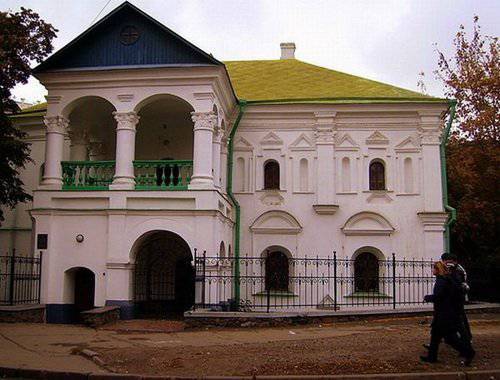
Instead of the modest bailiff Anichkov, under the highest order, Lieutenant General Ertel was sent to Little Russia, and under his authority a special "commission was set up to study fires in provinces acquired from Poland." Local governors were obliged to "render him every assistance". The police were instructed to fulfill the requirements of the general “precisely and without any delay”.
General Fedor Fedorovich Ertel was a person of the utmost remarkable. He was born in Prussia in 1768, entered the Russian service, distinguished himself in the war with the Swedes, captured the Swedish galley, first broke into the enemy's battery with a banner, was shot in the head with a bullet and lost his right eye. In a word, for whatever he took, he brought everything to the end and even injury, trying to serve not for fear, but for conscience. German quality was the general! Just Heinz Guderian in the Russian service! And Ertel got to the chairmen of the investigative commission, as he managed to serve for some time also as the chief police officer of Moscow. Not the general - gold! I could not find a better candidate, Alexander I decided.
Sending Ertel to the south of the Empire with extraordinary powers was an act of despair by the central authorities. It seemed to the king that he was being fooled. On the nose the war with Napoleon. All of a sudden, Kiev burnt down, and from there it was reported that the cause of the fire was juvenile fools, amused by fire. But nothing came of Ertel’s enterprise.
The brave general rushed to Kamyanets-Podilsky, where the detainee Trshalkovsky was sitting, and from there he began to correspond with the Kiev governor Miloradovich, demanding, according to the instructions, to render himself "every kind of assistance." The defendant sang a nightingale and gave out all the new details. In his words, they compiled detailed lists of “instigators” with a description of their appearance and sent them to cities demanding them to be caught and sent to Ertel. In order to get rid of the annoying German, the police from deaf counties began to send packs to Kamyanets-Podolsk, roped up in a hurry, Gypsies, horse thieves and small-town Jews. The photograph has not yet been invented, but according to the “descriptions”, they seem to have been “one to one” with the criminal individuals indicated by Tršalkovski. But with confrontations with the same Trshalkovsky, he did not recognize any of them.
Roads blocked barriers. Rural Sotsky was ordered to keep water barrels ready in case of future fires. A lot of people were seized - traders with indecent pictures, traveling salesmen, just foreigners, who were driving around on their business and seemed suspicious, even two Swiss pastors who were collecting alms, but the mysterious General Pashkovsky didn’t fall for all his horses. It was rumored that he had given a war to the Duchy of Warsaw and would return only in spring to continue the atrocities, and the skeptic Miloradovich generally believed that no General Pashkovsky and his “criminal squad” existed in nature. All this is the fruit of bureaucratic fears - a phantom.
"I YOU, CHANNEL, I KNOW!" The fog dissipated only when the head of the extraordinary commission, Ertel, instead of continuing to correspond with Miloradovich, sent Trshalkovsky to Kiev under protection. Seeing an outstanding saboteur - seeming to be some kind of snack - the Kiev governor was delighted: “Bah! Why, I know you well, Canal! You are a deserter, a runaway drummer of the local garrison! Admit it, who taught you to invent fables? "
The prisoner fell on his knees and admitted that he had lied, "hoping to get freedom and reward for that." He is not a member of any underground organization, and he simply invented General Pashkovsky. Thus ended the investigation into the version of Napoleon’s “saboteurs” who were abandoned in Kiev for the arson attack on the “mother of Russian cities”. Commission Ertel dissolved. The most universal general was sent to Mozyr to command the 2-m reserve corps.

And the memory of the Kiev fire remained the redevelopment of Podil. Now it is the only part of Kiev where the streets do not roam like drunk, but intersect perpendicularly to each other, as in St. Petersburg or New York. By the way, according to the conviction of Prince Dolgoruky, the fiery font went to the city in favor: “This whole part of Kiev got burned after my trip to 1811; now it is set up again, and the fire contributed to its decoration. The streets are divided much more correctly, the houses are built in the order and good drawings; everywhere gaps are observed to a decent measure. There is no previous cramped, the danger of which has been proved was so pernicious experience. Looking at the Hem from St. Andrew's height, you look exactly at the plan, which is spread out on the plain and seems to you in the drawing all the streets, back streets of the city. ”
Information